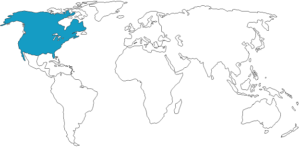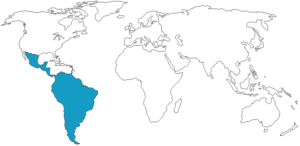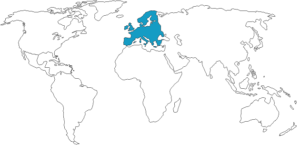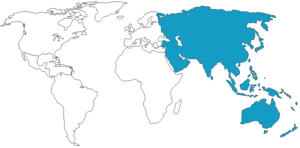2016 Global Trends: Online Payments Around the World
Examining Consumers’ Preferred Payment Methods by Region
Credit and debit cards are ubiquitous in many global markets, but not all. The diversity of alternate payment methods is, in fact, quite extensive.
Understanding regional consumer preferences and accepting popular payment options will help merchants increase sales and generate more revenue.
Analyzing Regional Payment Preferences
Earlier this year, Expert Market took a look at the most popular online payment methods in 29 of the world’s largest eCommerce markets across five different global regions. The resulting data suggests that consumers’ payment preferences can vary widely from one market to the next—something which merchants must anticipate before expanding outward.
U.S. & Canada
 Throughout U.S. and Canada, Visa and MasterCard are the dominant methods of payment, representing a combined total of 75% of all online transactions in both countries.
Throughout U.S. and Canada, Visa and MasterCard are the dominant methods of payment, representing a combined total of 75% of all online transactions in both countries.
Beyond the two primary card networks, PayPal is the third most popular payment method, capturing 15% of all eCommerce consumers in the U.S. and 10% of those in Canada. At the same time, Canadians also shop just as often through the Canada-only Interac payment transfer network as they do through PayPal.
American Express trails just slightly behind, being the preferred payment method of just 8% of U.S. shoppers and 5% of Canadians.
Analysis
It’s possible for a merchant to get by in the North American market accepting only Visa and MasterCard. However, it would be wise to consider accepting at least American Express and Discover as well, as these cardholders tend to spend more per transaction.
In fact, although Amex represented just 54.9 million of the nearly 800 million cards in the U.S. in 2014, they had the second-highest spend by brand—Amex customers charged $668 billion that year, in contrast to $607 billion spent by MasterCard customers.
Latin America
 The Latin American market is more diverse than U.S. and Canada. While Brazil and Chile closely mirror North America, with Visa and MasterCard representing 75% and 65% of sales in their respective markets, other nations buck those trends.
The Latin American market is more diverse than U.S. and Canada. While Brazil and Chile closely mirror North America, with Visa and MasterCard representing 75% and 65% of sales in their respective markets, other nations buck those trends.
For example, credit cards overall represent just 35% of online payments in Mexico, while bank transfers and cash-based payment methods such as OXXO and 7 Eleven services show comparable rates of usage.
In Argentina, the four most popular card brands include Visa and MasterCard, as well as Tarjeta Naranja and ItalCred; however, these still represent only a combined 42% of all online transactions. Payment cards in Argentina are narrowly edged-out by FinTech services such as Pago Facil and Rapipago, representing 44% of sales.
Analysis
Competing in the Latin American market is much more difficult for a variety of reason. Challenges primarily result from the range of different payment technologies and the increased risk of eCommerce fraud. While this leads many merchants to disregard the region, doing so also excludes a number of the world’s fastest-growing consumer economies.
A better solution may be for businesses to work with processors willing to accept payments from these diverse offerings, then deploy advanced fraud prevention technologies and services.
Europe
 Expert Market examined 11 different nations in the European market. As expected, Visa and MasterCard largely dominated Western Europe, actually showing higher rates of usage in the U.K., Ireland, Spain and Italy than in the North American market. In France, most payments involve payment cards through Cartes Bancaires, the French national interbank network, though such cards are typically co-branded by Visa or MasterCard.
Expert Market examined 11 different nations in the European market. As expected, Visa and MasterCard largely dominated Western Europe, actually showing higher rates of usage in the U.K., Ireland, Spain and Italy than in the North American market. In France, most payments involve payment cards through Cartes Bancaires, the French national interbank network, though such cards are typically co-branded by Visa or MasterCard.
In other countries, payments are less homogenous. For example, in Germany and The Netherlands, the most popular payment method is bank transfer, represented by iDEAL in The Netherlands and Elektronisches Lastschriftverfahren (ELV) in Germany. Poland, Russia and Sweden all show payment card usage rates below 50%, though the gap between payment card usage and alternate methods like online banking and FinTech services is less extreme.
The real outlier in the region is Turkey. Although credit cards represent more than 90% of all purchases, the introduction of the new TROY network is creating a great deal of uncertainty at present.
Analysis
While payments in Europe are more diverse than in the U.S., this is less a matter of necessity and rather one of personal preference. Even though consumers in countries like Germany, Sweden and The Netherlands prefer to use bank transfers, most will still have access to payment cards.
In most cases, European cards will either be co-branded with Visa or MasterCard, or will have an agreement with these brands, meaning that European card processing has few differences from North America.
Asia & South Pacific
 The sheer scale and wide-ranging diversity of the Asia-Pacific region makes it the most complex part of the globe by far in terms of eCommerce payments. Overall, Thailand and Australia are the only countries in which Visa and MasterCard are the preferred payment methods for consumers; the rest of this region is dominated by alternate card brands, OTC cash payments, and various FinTech platforms.
The sheer scale and wide-ranging diversity of the Asia-Pacific region makes it the most complex part of the globe by far in terms of eCommerce payments. Overall, Thailand and Australia are the only countries in which Visa and MasterCard are the preferred payment methods for consumers; the rest of this region is dominated by alternate card brands, OTC cash payments, and various FinTech platforms.
In terms of card brands, the big players in the region are UnionPay (the primary interbank card network in China) and JCB (a Japanese issuer with a major international presence). However, through agreements between international card brands, most localized brands can be processed through Visa and MasterCard’s networks.
Overall, the data suggest that cards are the preferred online payment method in all of the 12 countries in the region included in the study. Where they differ is in the subsequent choices.
For example, 35% of Chinese consumers prefer to use credit or debit cards to make a purchase. Of the remaining share of the population:
- 25% use Alipay, the proprietary FinTech platform of eCommerce giant Alibaba
- 10% prefer FinTech platform TenPay
- 10% use UnionPay’s proprietary FinTech platform
- 10% would rather pay in cash or using prepaid cards
- 5% opt for online bank transfers
- 5% choose to use another mobile wallet or FinTech platform
Chinese consumers are not alone in their range of preferences. Overall, seven of the 12 countries studied—China, India, Indonesia, Japan, South Korea, Taiwan and The Philippines—listed at least five different significant payment methods.
To better evaluate the relevance of these countries’ buying power, three of those nations are among the top five most populous countries on Earth, and combined, all seven equal close to half of the total global population. In all, that’s a significant factor to consider.
Analysis
Overall, the Asia-Pacific region is not just the world’s largest market for eCommerce, but also perhaps the world’s most unpredictable. Trying to define this entire region at large offers little valuable insight, but there are broader trends worth examining.
Specifically, the fact that several of this region’s largest economies are also still among the world’s fastest-growing. Unlike Western markets which were already developed by the time eCommerce arrived, economies such as India, Indonesia and The Philippines are now developing alongside eCommerce.
While payment cards were already standard in North America and Europe by that point, these markets are maturing with factors such as FinTech being adopted naturally, rather than bursting onto the scene as disruptive forces. Therefore, we are likely to see alternative payment technologies being adopted much more readily by these still-developing markets.
Changing Markets Means Opportunities and Uncertainty
Merchants and processors face a number of opportunities going forward, but those opportunities present additional challenges. Between rising markets, disruptive technologies, and ever-changing consumer expectations, there is not much which is now absolute.
Expanding into the global market means merchants need a carefully constructed risk mitigation plan to accompany any plans to seek out additional revenue.
In the end, merchants who craft dynamic and agile solutions will find the greatest success in international markets.
Last Update: November 8, 2016
Tell us how can we improve this post?
Are you interested in a topic we haven’t covered yet? Use our Submit a Question feature to request additional information from our contributing experts.
